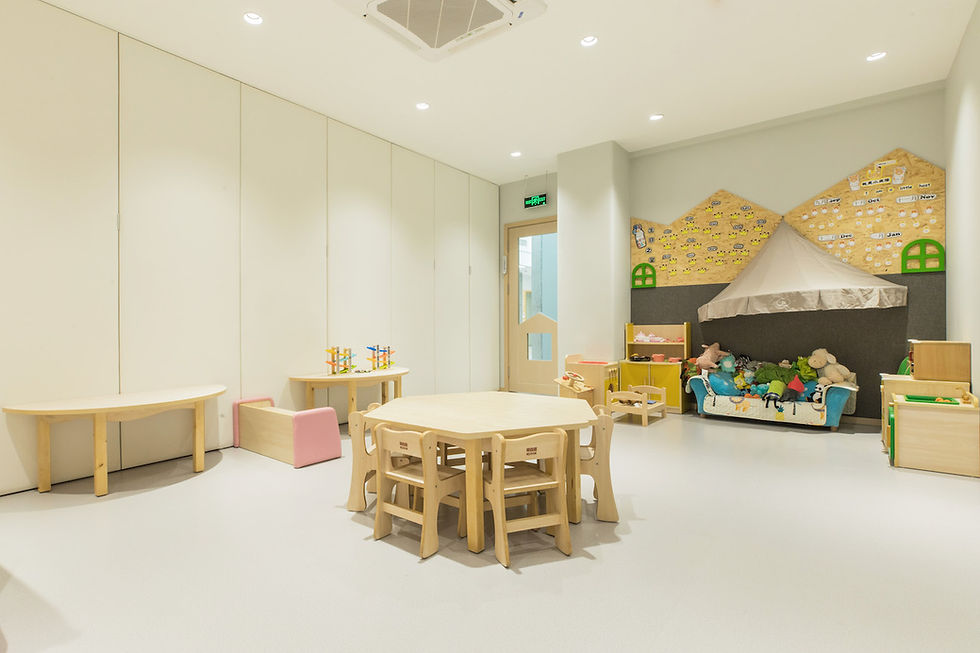Designing Inspiring Kindergarten Classrooms
- info623127
- Sep 3
- 3 min read
Creating an inspiring kindergarten classroom is crucial for nurturing young minds. A well-designed space can motivate and engage children, helping them to discover their potential and love for learning. This blog post will provide practical ideas and tips for designing effective kindergarten classrooms that foster creativity, collaboration, and exploration.
Classroom Design Ideas for Young Learners
The design of a kindergarten classroom should be vibrant and welcoming. Bright colors, interactive displays, and functional furniture contribute significantly to the overall atmosphere. Here are some key design ideas to consider:
Colorful walls and decorations: Choose soft, calming colors for walls, paired with engaging artwork or educational motifs. A pale yellow or light blue can create a cheerful ambiance. Use bulletin boards to showcase student work, which fosters pride and encourages participation.

Library, Victoria Shanghai Kindergarten, Qibao Campus Flexible seating arrangements: Traditional rows of desks may not be suitable for young children. Incorporate various seating options, such as bean bags, floor cushions, or small tables to accommodate different activities. This flexibility encourages movement and collaboration among students.

Library, Victoria Shanghai Kindergarten, Gumei Campus Defined learning areas: Create distinct areas for various activities such as reading, art, and science. Utilize rugs or mats to define these spaces, making it easier for children to transition from one activity to another. Providing a cozy reading nook filled with books encourages independent exploration.

D & T Workshop, Victoria Shanghai Kindergarten, Gumei Campus
Natural Light and Outdoor Connections

Incorporating natural light into the classroom is essential for creating a positive learning environment. Windows provide natural illumination and connection to the outside world. When planning your kindergarten classroom design, consider the following:
Maximize window space: Use sheer curtains to allow light while minimizing distractions. Arrange seating to take advantage of natural light, which can improve mood and concentration.
Create an outdoor learning area: If possible, design a space adjacent to the classroom that allows for outdoor learning. This area can feature gardens, science stations, or artistic installations that enhance inquiry-based learning.

Incorporating Play Elements

Play is an integral part of early childhood education. Designing spaces that promote play fosters creativity and exploration. Here’s how to create engaging play areas within the classroom:
Interactive play stations: Set up stations that promote different types of play, including imaginative play and sensory activities. For example, create a "kitchen corner" with play foods and utensils, allowing children to role-play while enhancing social skills.

Maker's Room, Victoria Shanghai Kindergarten, Pudong Campus Outdoor play equipment: If your school has outdoor space, invest in safe play equipment such as swings, climbing structures, or sandboxes. These features encourage physical activity and help children develop motor skills.

Fostering Creativity Through Design
A kindergarten classroom should inspire creativity. Here are strategies to create an environment that nurtures artistic expression:
Art supplies at hand: Designate a space for art supplies, ensuring children can easily access materials such as crayons, paints, and crafting items. Display student artwork to celebrate their creativity.

Art Room, Victoria Shanghai Kindergarten, Qibao Campus Incorporate technology thoughtfully: Utilize tablets or computers to enhance lessons and engage students. Interactive programs can introduce subjects like mathematics or language in a fun and dynamic way.

Innovation Hub, Victoria Shanghai Academy, Hong Kong
Creating a Safe and Inclusive Environment
Safety is paramount in kindergarten settings. Here are some tips to ensure a secure and welcoming classroom:
Use child-friendly furniture: Select furniture that is appropriately sized for young children. Ensure all items have rounded edges to minimize the risk of injury.

Indoor Play Area, Victoria Shanghai Kindergarten, Pudong Campus Establish clear boundaries: Use physical structures or visual cues to define areas and maintain organization. This helps children understand expectations and fosters a sense of security.
Promoting Collaboration and Social Skills
Encouraging teamwork and communication are essential aspects of kindergarten education. Adjust your classroom layout to facilitate collaboration among students:
Group workspaces: Arrange desks or tables in small groups, promoting peer interaction. This setup encourages discussion and reinforces learning through collaboration.

Classroom, Victoria Shanghai Kindergarten, Gumei Campus Shared resources: Provide communal resources such as puzzles, games, or books to promote cooperative play and social skills development. Create opportunities for children to work together as they learn.
Final Thoughts on Classroom Design
Designing an inspiring kindergarten classroom is not just about aesthetics; it is about creating an environment that supports learning and development. Thoughtful classroom design reflects the importance of fostering engagement, creativity, and social skills in young children.
Investing time and effort into a well-planned environment can significantly enhance the educational experience. For more comprehensive insights on kindergarten classroom design, consider checking out more resources at Mad Studio. The space a child learns in can shape their love for education and exploration for years to come.




Comments